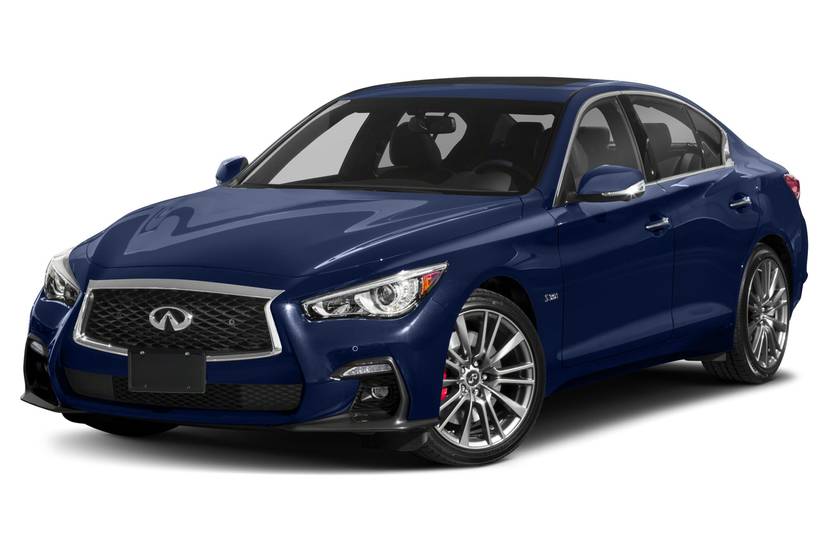
The 2018 Infiniti Q50 is the latest iteration of one of Infiniti’s most popular cars, the compact luxury sedan originally named G35. The G35 was one of the first cars I had an automotive crush on, arriving on American shores the same year I got my driver’s license — 2002.
The new model year brings a light refresh for the Q50 that includes a new trim level structure. There are now four trims: Pure, Luxe, Sport and Red Sport 400. Each of the three engine options carry over: a turbocharged 2.0-liter four-cylinder; a twin-turbocharged 3.0-liter V-6; and an up-tuned version of the latter for the Red Sport 400. The Pure comes only with the smaller engine, Luxe offers a choice of either, and the Sport and Red Sport 400 come only with the V-6. Infiniti offers rear- or all-wheel drive (for $2,000) across all the Q50’s trim levels and engine options.
Exterior changes include a new grille up front and a revised front fascia with new foglight housings. Inside, there’s a new steering wheel but not much else to speak of; the old dual-screen multimedia system remains. Q50 Red Sport models get the best leather and dark-chrome accents. A long list of safety technology is available. Compare the 2018 Q50 with last year’s model here.
I tested a Q50 3.0t Sport with the larger engine and a few additional option packages, including the Essential Package ($2,500), ProAssist Package ($1,650), Performance Package ($1,500) and Sensory Package ($2,650), which drove the price up from the 3.0t’s starting point of $41,645 (including destination) to $50,410. Here are more details on what we tested:
2018 Infiniti Q50 3.0t Sport
- Powertrain: 300-horsepower, twin-turbo 3.0-liter V-6 and 295 pounds-feet of torque; seven-speed automatic transmission; rear-wheel drive
- Estimated fuel economy: 20/29/23 mpg city/highway/combined
- Key features: Dual-display system, navigation, blind spot warning, 360-degree cameras, forward autonomous emergency braking, Dynamic Digital Suspension, 16-speaker Bose audio system, front and rear parking sensors
- Price: $50,410 (including destination)
How It Drives
My favorite part of the Q50’s performance was the 300-hp, twin-turbocharged 3.0-liter V-6 that makes 295 pounds-feet of torque. The up-tuned version in the Red Sport 400 makes 400 hp (oh, now I get the name) and 350 pounds-feet of torque. The 2.0t’s 208-hp, turbocharged 2.0-liter four-cylinder makes 258 pounds-feet of torque.
Downscaling to the four-cylinder doesn’t net you much fuel-economy gain: an estimated 23/30/25 mpg for RWD models and 22/28/24 mpg with AWD. The 3.0t costs only 2 mpg combined (20/29/23 mpg with RWD, 19/27/22 mpg with AWD). Red Sport versions are similar, at 20/26/22 mpg with RWD and 19/26/22 mpg with AWD.
The reason I pinpoint the bigger engine as my favorite part of the Infinity Q50’s driving experience is because what’s attached to it is disappointing. The only transmission is a seven-speed automatic, and it’s a wet blanket even in the Q50’s more aggressive driving modes. My test car thankfully included the Performance Package, which added the adaptive Dynamic Digital Suspension, sport brakes and paddle shifters. The paddles were a godsend; choosing gears myself let the engine shine. It’s quick to get into its power and likes to rev, but any time I left the automatic to its own devices, there was a noticeable lag between pushing down the accelerator and any forward motion. There was a delay in acceleration while hoping the transmission would kick down a gear or two, as well as when mashing the pedal hard, hearing it hit the floor and then waiting for the car to realize, “oh, I should be moving.”
For a sedan of this price with sporty aspirations (it has Sport in its name, after all), the Q50’s handling leaves a lot to be desired. Even with the Dynamic Digital Suspension equipped — which firms up the suspension in more aggressive drive settings — I found there to be too much body roll. It made the car feel heavy in turns, which made me less confident to push it. Steering was not much better; it’s missing feedback and doesn’t feel linear coming off center. As a cruiser, the Q50 is fine, but when I asked more of it, I was left wanting. When you consider that the Infinity Q50 competes against agile and engaging cars like the Alfa Romeo Giulia and the Cadillac ATS, its shortcomings are highlighted even more.
Two Screens for What?
Inside, most of the center console is dedicated to the Q50’s dual-screen multimedia system. The top screen is recessed into the dash, where it displays navigation maps, phone functions (via Bluetooth) and the Infinity Q50’s camera display. To control this screen, you’ll have to use either a small knob behind the gear selector or your voice.
The lower screen, however, is a touchscreen. It sits in a flush, glossy panel and is surrounded by climate control buttons on either side and three buttons below (Audio, Menu and Climate) to help navigate the onscreen menus.
I found the audio, climate and performance systems in the touchscreen easy enough to use, but the top display is a mess. The dial isn’t intuitive, which makes using the top screen — which houses some important functionality you can’t avoid — a chore. The 2018 Acura TLX has a similar two-screen setup with many of the same limitations. I didn’t like using the Acura’s weird dial for its top screen, either, but the TLX has a killer feature that the Q50 lacks: Android Auto and Apple CarPlay, which make the top screen much more useful.
Because the Infinity Q50 doesn’t offer those smartphone-mirroring technologies, the only option is to use Infiniti’s system, which either stymied or frustrated me multiple times in the week I drove the Q50.
Interior
The rest of the interior is more competitive. The Sport 3.0t comes with real leather upholstery standard, and I found the sport seats to be supportive and comfortable. I did a long highway drive in the Q50 and didn’t feel any fatigue or soreness afterward.
The backseat doesn’t have much legroom, but that’s true of most of this class. Headroom is good, and the Q50 has large windows all around, which helps provide good visibility from all seats. Cargo room is 13.2 cubic feet for four-cylinder models and 13.5 cubic feet for V-6 models. That puts the Infinity Q50 mid-pack, with less room than the Acura TLX, about the same as the Audi A4 and a bit more than the Mercedes-Benz C300. Compare the Q50’s other specs and features against those models.
Safety Not Guaranteed
Conclusion
The 2018 Infinity Q50’s updates don’t go far enough for me and definitely don’t solve the car’s biggest problems: a multimedia system and driving experience that don’t match the competition. We’ll have to get behind the wheel of a Red Sport 400 AWD to see if it holds up better (it does have a different steering system than the one on the 3.0t Sport I drove), but I’m skeptical — added horsepower doesn’t solve all ills.
The Q50 has its appeal as a stylish car that performs well enough as a cruiser. But with parts that are below average for this luxury class — including ones you interact with on a regular basis — the Q50 lags too far behind its competitors.
Cars.com’s Editorial department is your source for automotive news and reviews. In line with Cars.com’s long-standing ethics policy, editors and reviewers don’t accept gifts or free trips from automakers. The Editorial department is independent of Cars.com’s advertising, sales and sponsored content departments.











